As a continuing effort to get the word out, I put together a simple infographic for use on Pinterest and as a poster. It is a first attempt and a little repetative if you have been following the blog, but please let me know what you think.
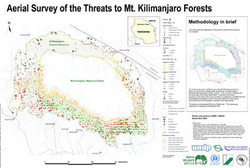 Although much of the threat to Kilimanjaro’s snowpack has been link to climate change, this does not mean that its effects cannot be mitigated or even reversed. True, it will take a lot of cooperation and quite a while to see the results, but that does not mean that it is not worth doing. We can make a change and it will take all of us humans to learn and act in whatever little way possible. As better than organic farmer Joel Salatin says, “Anything worth doing is worth doing poorly at first.” His example is that of a new toddler. When the baby uses a piece of furniture to wobbly stand itself up and then shakily try to cross the living room, we don’t scold the child and say, “If you’re not going to do it right, don’t do it at all”, we ooh and ahh and praise the child. Someone did it for us and we all walk most of the day without falling down (maybe that’s just me). However, there are local (African) threats to Mt. Kilimanjaro. The main threat sited by the United Nations Environmental Programme on the southern slopes of the mountain relate to the loss of forests from fires and illegal logging. The group also points out that Mt. Kilimanjaro’s extensive forests with high rainfall make it a large catchment for both Kenya’s and Tanzania’s water with 96% of the water coming from Kili coming from the tree belt area. http://www.unep.org/dewa/Assessments/Ecosystems/Land/ThreatstoMtKilimanjaroforests/tabid/6966/Default.aspx Logging with re-plantation of non-indigenous species on the northern slopes offer similar problems. In regards to the deforestation of the slopes, further development and strength in the national park’s enforcement of its boundaries would help, however much the deforestation is for subsistence cooking fuel and tree poaching for plantation or construction. Basically the locals are trying to fight their poverty without a concept of the long term consequences. Education should be the more focused tool, but also providing other means of earning a living such as the responsible tourism practices (like the guiding services and lodges mentioned in previous blogs). Another way to combat deforestation is to try and only use woods or wood manufactured products that can be verified that they come from sustainable and fair labor/trade sources. The two most recognized international certification programs for sustainable wood and forest source goods are the Forest Stewardship Council (FSC) (both international and U.S) https://ic.fsc.org/ and Programme for the Endorsement of Forest Certification (EU based) http://www.pefc.org/. Visit their sites to learn more about sustainable forest initiatives, how they certify and you can even donate to these groups. Besides only harvesting good woods, we can help replace what has been taken with tree planting programs and organizations. One mentioned in a previous blog is the Kilimanjaro Eco Lodge where tree planting trips can be scheduled into your stay. Another would be to volunteer or donate to groups such as the Kilimanjaro Environmental Conservation Management Trust Fund http://www.kilimanjarotrust.org/index.html. The Trust Fund identifies six areas of concern; Land degradation, Inadequate water supply, Pollution, Habitat fragmentation and loss of biodiversity, Deterioration of aquatic systems, Deforestation and Frequent forest fires, that they try to address with their programs and reforestation efforts. 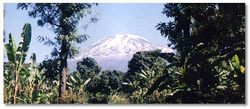 Vibrant African Forests around Mt. Kilimanjaro Please remember, that although it seems like everyone asks for money, 1) a healthy donation is still cheaper than flying to Africa (and a smaller carbon footprint) and 2) money is a tool that is extremely versatile and does not spoil. It can be used in a variety of ways that time and muscle may not meet.
So as with all aspects of things you care about, be thoughtful, research where your money is going, whether it is a guide, food, lodge or where to donate and make it count. The other home front effort that anyone and everyone should be carrying out and getting a little better at everyday is to try and lower your carbon footprint in the thousands of ways we know. It truly is the Butterfly Effect that you unplugging your computer or turning on a fan instead of the A/C in Utah, the U.S. or wherever may keep the Snows of Kilimanjaro around just a little longer. Thanks for your efforts in advance! 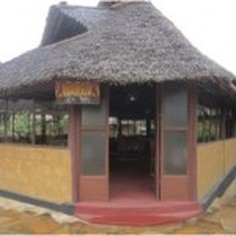 Entrance to the Kilimanjaro Eco Lodge Cantina Although all trips into the Kilimanjaro parks must be booked with guided services that knowledgeable regulated for the mountain’s and locals wellbeing , there is also the issue of supporting sustainable tourism in the surrounding area that is the extended environment of the mountain. In the Boy Scouts, we teach that when you camp in an area that you might trample the grasses in the area from hiking or setting your tent up on them, you have to un-matt the grasses with your hands before you leave the nest day so the grasses do not get crushed and develop into packed soil where nothing grows. The top grassy layer with soil and needles and leaves and pinecones is called “duff”. To create minimal impact, you Fluff your Duff. One business in the area that appears to have the beauty and sustainability of the zone in mind is the Kilimanjaro Ecolodge. (http://kilimanjaro-ecolodge.com/ ) Located in Arusha outside of Mt. Meru and Kilimanjaro parks, the Kilimanjaro Ecolodge strives to maintain local means and cultures for tourists to experience, without making them just a display. The Lodge uses local materials and laborers using traditional architecture for its buildings, handmade local soaps for its guests and traditional meals from its onsite organic garden and dairy (cows, chickens and goats). The garden also uses the lodge’s grey water and composted food waste. Much of the lodge’s water comes from collected rainwater and some of it power from solar, with the lodge planning on expanding into bio-gas in the future.
The lodge also meets a great point of successful tourism without exploitation by offering many cultural experiences. The lodge can arrange market, coffee farm and village tours as well as traditional cooking classes and even home-stays in the local village. They can also offer or arrange a variety of nature and park hikes including trips into Arusha National Park and Mt. Kilimanjaro. There are also a variety of volunteer opportunities that range from work with local schools, NGOs and even tree plantings. I would highly recommend inquiring into the Kilimanjaro Eco Lodge for your visit based on its cooperation and healthy exposure to the local environment and culture while contributing and even having a positive impact on the local work force, physical environment and people. 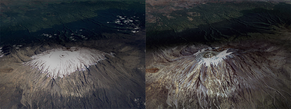 Picture showing the changes in the Kilimanjaro snowfields. Climate change is driving the loss of the snows on Kilimanjaro. As glaciologist Lonnie Thompson from Ohio State University in Columbus points out in an article from the National Geographic News Service online, it is the melting of the glaciers from the margins and periphery, but also the thinning of the ice packs (John Roach, NG News, Nov. 2 , 2009). To quote the article: Thompson and his colleagues have studied Kilimanjaro's dwindling ice for several decades. The mountain, they say, has lost 85 percent of its glacial ice since 1912. What's more, 26 percent of the ice that remained in 2000 was gone by 2007, the last time Kilimanjaro's ice was precisely mapped. They also state that up to 50% of the glaciers thickness has disappeared since 2000, and the mountain could be ice free as early as 2018. This melting is coming from increased temperatures in the region as well as changes in the amount of precipitation also affected by temperature. There is also a study that is beginning to link weather changes to deforestation in a 2,000 mile area around the mountain (http://www.sciencedaily.com/releases/2011/03/110305112136.htm). Although not conclusive either way in the ongoing study, this is only another factor that may be teamed up with weather patterns generated off the Indian Ocean. 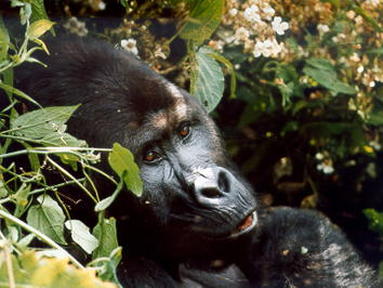 The low land gorilla's habitat is threatened by illegal logging, deforestation and war. Having pointed out some of the concerns about Mt Kili, I would also like to introduce you to another endangered African National Park. This park is Kahuzi-Biega National Park in the Democratic Republic of Congo (http://whc.unesco.org/en/list/137/) . This area of tropical rainforest that has a long list of unique flora and fauna (the most notable charismatic mega-fauna being the low land gorilla) faces many challenges. When it comes to the five successfully sustainable management principles, it fails to collaborate with the local populace with no real fit between its communities and tourism. Probably the saddest component is that it has no way to protect its natural resources. UNESCO recalls that since the parks’ inception there has been strife from villagers that were incorporated into the park as well as no delineated boundaries to protect from deforestation and oil exploration as a means to combat poverty in the region. War, political instability and its refugees have fled into the forests as they were displaced have also affected the parks with resource use and degradation. Enforcement is also minimal as the parks are described as “under-staffed”. 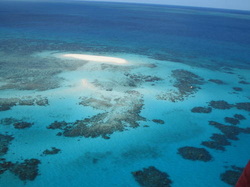 The Great Barrier Reef It is probably not a fair comparison, but a completely different biome can be managed in a much more successful manner. As a huge underwater ecosystem (able to be seen from space) The Great Barrier Reef off of the coast of Australia has different protections in that it can be treated somewhat like an island by the protecting government http://whc.unesco.org/en/list/154. Although, it is not truly isolated like an island might be, it is actually guarded by many overlapping jurisdictions. It has the local government of Queensland, as well as being a Federal Marine Park overseeing and cooperating in its use and study. This is collaboration to protect its resources also helps manage it as a learning and research area as well as recreational multi-use resource. Besides boating and diving, overseeing agencies also set guidelines for travel, shipping, fishing/harvesting and sea dumping. They also engage the indigenous cultures with Traditional Use of Marine Resource Agreements (TUMRAs) and Indigenous Land Use Agreements (ILUAs) to support Traditional Owners to maintain cultural connections with their sea country. Although the reef is actually soaking in the ocean and all the environmental changes that can be passed through it (pollution, rising sea temperatures and invasive species blooms), it is the strong and multilayered cooperative that protects this biome and ensures its enjoyment by all.
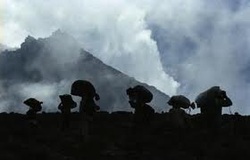 Porters under heavy loads of equipment and food In my continuing research on Mount Kilimanjaro, I looked into how the National Park (Mount Kilimanjaro National Park, under Tanzania National Parks) makes efforts to meet the varying aspects of fair trade in tourism. Although quite a few of the travel companies and adventure groups I found list several points on their sites about their efforts, after reading Mount Kilimanjaro National Park Regulations, (http://www.tanzaniaparks.com/regulations_and_park_fees.html) and (http://www.tanzaniaparks.com/useful_docs/National_Parks_Mountain_Regulations.pdf) I discovered these features are not unique to the groups, but mandated by the park for the companies’ operation within the park. They include the Five Cornerstones of Fair Trade of Responsible tourism.
1) Fair Working Conditions: All guides porters and cooks are to be proven and documented as healthy, honest and trustworthy and are to be properly outfitted and equipped for their trek. They are to be registered members of a porters association. They are also limited to 18-25kg of weight to be carried. 2) Fair Prices: Fees per day are posted for guides, porters and cooks (all of whom are required per trekking group in the park). $10 (US) per porter per day, $15 per cook and $20 per guide. There are also park fees and fees for each activity in the park. 3) Integration Into the Local Economy and Regional Development: As a National Park, there is no development in the Park but a few private investor funded lodges (some room for leakage), and all employees of the park are locals. 4) Fair Trade Partnerships Between All Actors in Tourism: This area is a little tenuous as all groups must be accompanied by park approved local guides, porters and cooks; travel packages through companies (even though approved by the Parks system) get their cut. 5) Sustainable Resource Use and Environmental Justice: Restrictions in the park are fairly stringent as to number of groups and the number of members per group. All routes and camping/lodging stops are planned and approved as to prevent congestion and concentrated impact. All food containers must be labeled with the travel company’s name (for identification and recognition if left behind) and all trash is packed out. There are designated toilet facilities that must be used or waste carried out. There are no wood fires permitted in the park either. I was able to find another company called G Adventures that appears to have a very good sustainable touring program as well as Voluntours. Their porter guidelines seemed more developed than the Kilimanjaro requirements, but I could only find their link to their Peruvian guides. I would recommend checking their site out at http://www.gadventures.com /. 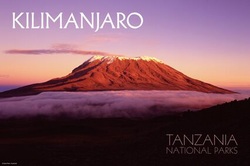 I would like to start by saying I'm sorry for a site that initially sounds like
a downer. I am excited though... There are several important reasons I am writing this site. I feel the most important to me is acutally selfish. I have never been to the African continent. I know that I will someday make the journey. What I am not sure of is if some of the cultural and natural focal points will be the same by the time I get there. We all talk about "Wanting it there for our children", but I have not experienced why that should be for this mountain. Basically, I want to hike Mount Kilimanjaro and its snowfields and glaciers. However, the possible collapse of this ecosystem may not be a unique case. The physical natural world is changing and humans (as I'll point out later) are one of those causes. We may lose similar ecosystems around the world. What can affect one biome can affect many. What we learn and do in one we can learn and do in another. I hope to also explore and provide information on how the combination of travel, the physical act of participating in a place, and environmentally sound practices can help to protect and maybe even recover these places we hope to one day touch. That maybe these places will last longer than individual humans. That we might pass before they are gone. |
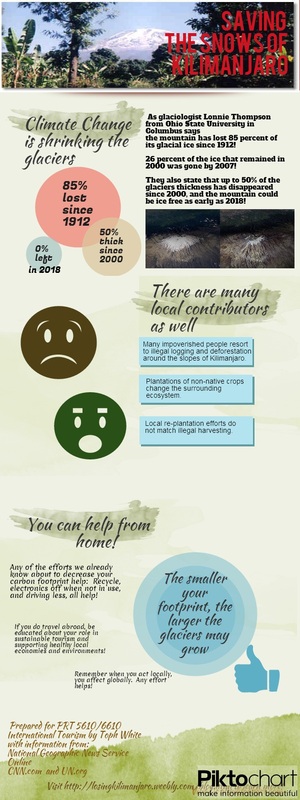

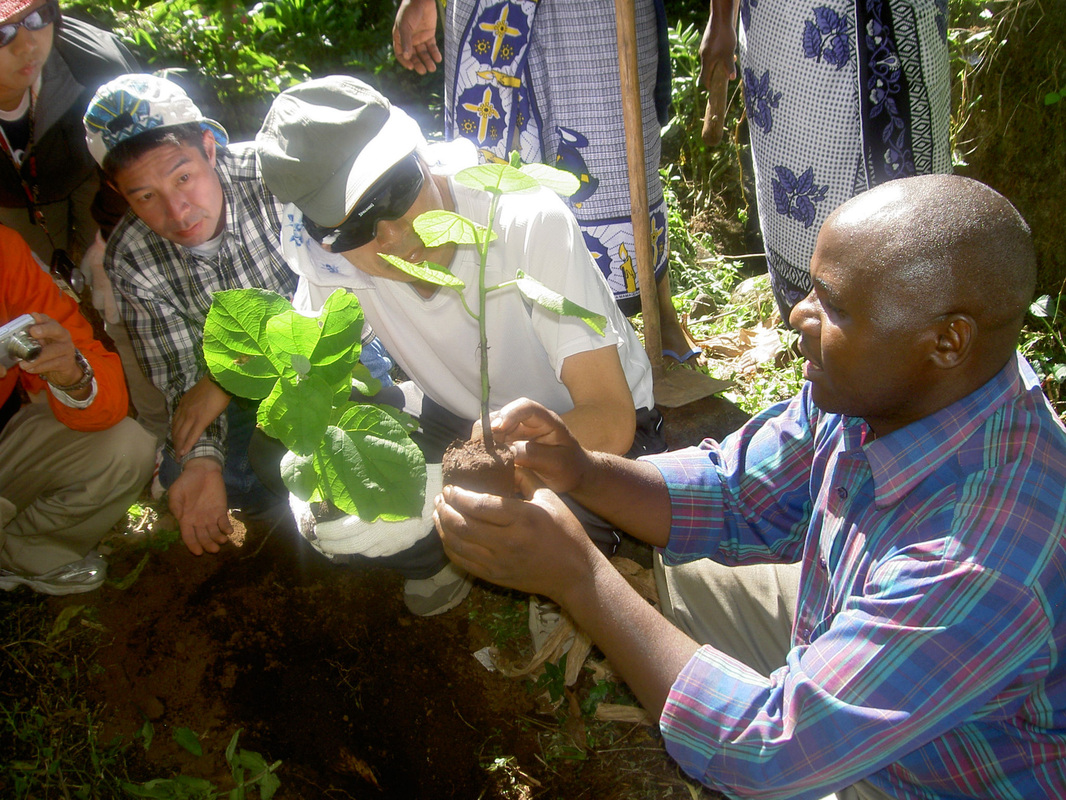
 RSS Feed
RSS Feed